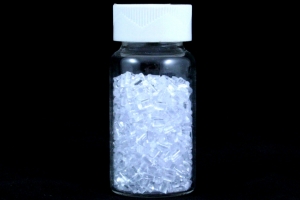
We rarely notice this naturally transparent, cheap, lightweight and shatter-proof substitute for glass, whose pseudonym – Perspex – derives from the Latin ‘to see through’. Acrylic is a material of many names, otherwise known as Perspex, Plexiglas, Lucite, Acrylite, Polycast and Altuglas, to name but a few of its alter egos. These substances are all essentially variants of the same plastic made from a chemical called methacrylate. Poly(methyl methacrylate) - or PMMA for short for us lazy materials enthusiasts - is the most common acrylic plastic.
It was first developed in the early 1900s by a German chemist. Since then, the process for making acrylic has been refined to give us a highly transparent thermoplastic that is relatively scratch resistant (for a clear plastic), very stable in UV light (it doesn’t yellow in sunlight like the celluloid that came before it), and although it’s quite brittle by comparison to more impact-resistant plastics like polycarbonate, much less likely to shatter than glass.
Because it is one of the clearest plastics we have, acrylic first found favour in the 1930s as a glass substitute in safety goggles, as well as World War 2 military applications like gas masks, submarine periscopes and cockpit windows. Because of this superb clarity, acrylic is also the material of choice for enclosures around exhibits in museums and galleries, including Damien Hirst’s array of unfortunate perspex-encapsulated and formaldehyde-pickled animals.
You probably also have acrylic to thank for your next endoscopy: PMMA is a cheaper, more flexible and more robust alternative to glass optical fibres, which comes in handy when we need to shine a light inside our bodily cavities to see what’s going on in there. Check out our Materials Library entry on plastic optical fibres for more info.
Acrylic is also quite well-suited to being implanted into our bodies. Although the first clinical application of PMMA was in 1930s, when it was used to repair cranial defects in monkeys, acrylic wasn’t used to repair human bodies until the 1940s. Its biocompatibility was discovered accidentally when World War 2 pilots whose eyes were injured by shards of broken acrylic from plane cockpits fared much better than those affected by shards of shattered glass. These tragic injuries led directly to the invention of the first prosthetic intraocular lens: a dome of acrylic that was implanted into the eye to replace the natural lens as part of cataract surgery. Acrylic is also used extensively used in dentistry, where its similarity to human dentine has seen it take over from ivory, animal bone and human teeth as the denture, dental implant and dental crown material of choice. Orthopaedic surgeons have also caught on to acrylic’s advantages, developing PMMA ‘bone cement’: a kind of space-filling plastic ‘grout’ that sits between our bones and an artificial knee or hip joint, absorbing shock and distributing pressure.
To learn more about acrylic’s many talents, including its use in piano keys, Cardi B’s glorious nail art, David Hockney’s technicolour scenes of Californian suburbia and more, read our longer blog post.
Sample ID: 246
Particularities
- Selections
- Categories
- Polymer
- Curiosities
- Relationships
- Biocompatibility | Biocompatible | Casting | Cosmetic | Glass | Implants | Plexiglass | Shatter-resistant | Surgery | Thermoplastic | Transmits light | Transparent
Add materials you find interesting to your own selections.
Use the  button to select a material and get started.
button to select a material and get started.

